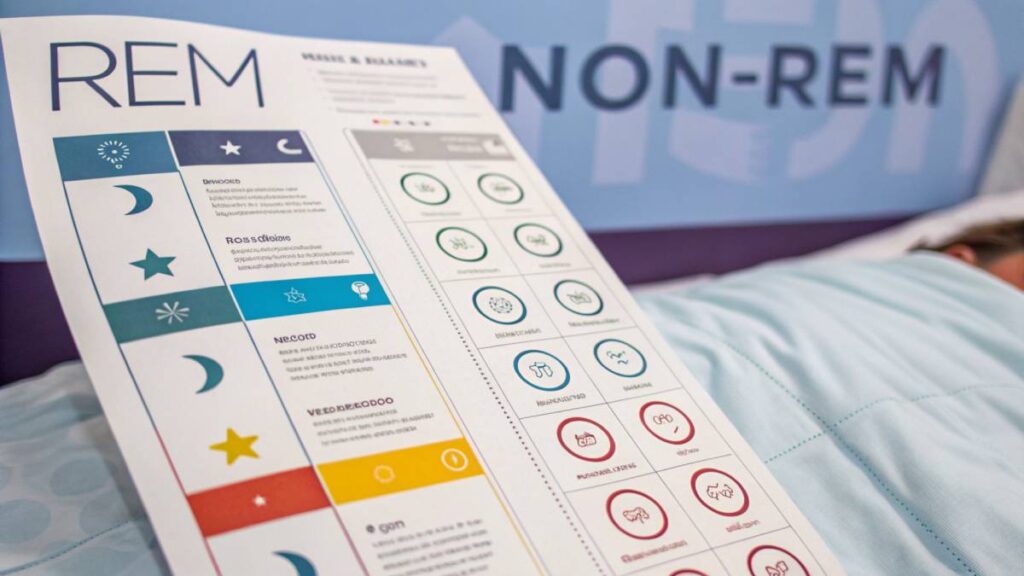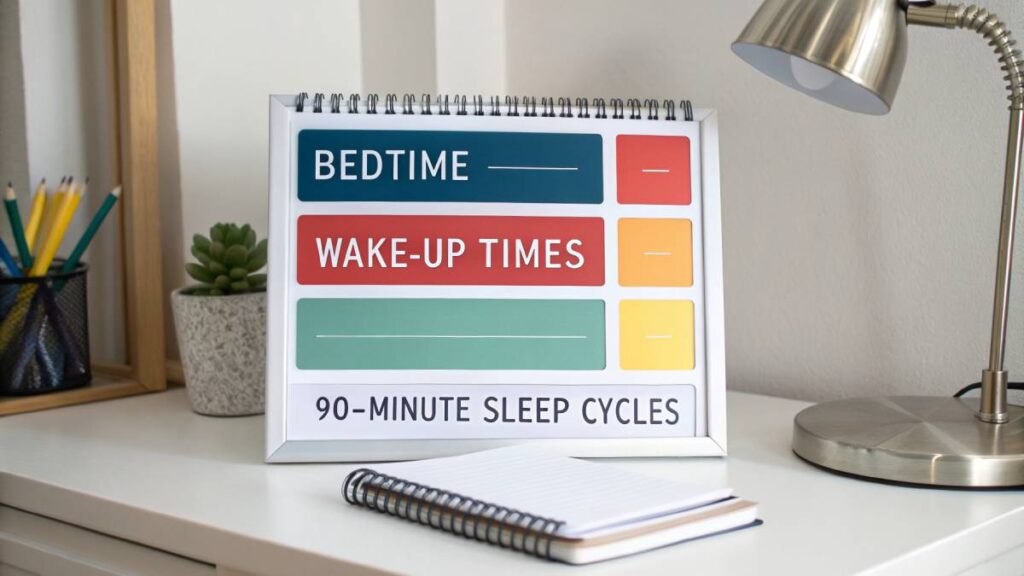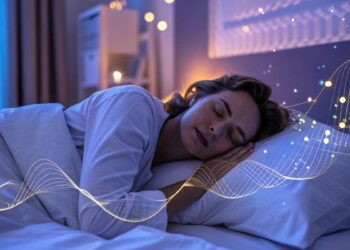Imagine waking up every morning feeling fully refreshed and energized, ready to conquer the day ahead. The key to this rejuvenating morning routine lies in understanding your body’s natural 90-minute sleep cycles. By aligning your sleep patterns with these cycles, you can significantly improve sleep quality, boost your health, and enhance overall well-being. Dive into the science of sleep and uncover practical strategies to transform your nightly rest into a powerhouse of recovery and vitality.
Main Key Takeaways:
- Understanding Sleep Cycles: Grasp the importance of the 90-minute sleep cycle, including REM and Non-REM stages, for overall health.
- Optimizing Sleep Schedule: Learn how to set bedtimes based on desired wake-up times to align with complete sleep cycles.
- Improving Sleep Quality: Implement sleep hygiene practices and relaxation techniques to enhance the efficiency of your sleep.
- Health Benefits: Discover how adequate sleep supports immune function, cardiovascular health, weight management, and mental well-being.
- Practical Strategies: Utilize tools like sleep trackers, nap strategies, and gradual adjustments to personalize your sleep routine.
Why Understanding the 90-Minute Sleep Cycle is Important
Understanding the 90-minute sleep cycle can be a game-changer when it comes to enhancing your sleep quality. Imagine waking up feeling refreshed and energized, rather than groggy and disoriented — this is the power of aligning your sleep with your body’s natural rhythms!Let me share a quick story. A friend of mine, who constantly battled fatigue, discovered the connection between sleep cycles and sleep quality through a chance encounter with a sleep consultant. After adjusting his sleep schedule to align with the 90-minute cycles, he reported that he’d wake up more naturally, feeling invigorated and ready to tackle the day!
This transformation stemmed from the understanding that our brains operate in cycles rather than rigid blocks of time, which allowed him to leverage each cycle for optimal rest.The significance of the 90-minute sleep cycle goes beyond mere anecdotal evidence. Research shows that the human body typically goes through a complete sleep cycle in approximately 90 to 110 minutes. This cycle encompasses various stages of sleep, including both Non-REM and REM phases, each playing a unique role in restoration and cognitive function. Understanding this cycle can help you make better decisions regarding your bedtime, leading to improved mood, productivity, and overall health.
Overview of Sleep Cycles
To fully grasp the importance of the 90-minute sleep cycle, it’s essential to have a clear overview of how sleep is organized. Our sleep is not uniform; rather, it’s divided into distinct stages that repeat throughout the night. Here’s a simplified breakdown of the sleep architecture:
| Sleep Stage | Duration/Percentage | Description |
|---|---|---|
| N1 (Light Sleep) | 5% | Brief period transitioning from wakefulness to sleep. Light and easily disturbed. |
| N2 (Moderate Sleep) | 45% | Characterized by sleep spindles; the heart rate begins to slow, and body temperature drops. |
| N3 (Deep Sleep) | 25% | Known as slow-wave sleep; vital for physical restoration and strength recovery. |
| REM (Rapid Eye Movement) | 25% | Associated with dreaming; crucial for emotional regulation and memory consolidation. |
During a typical night, you’ll cycle through these stages multiple times, with each complete cycle lasting around 90 minutes. As the night progresses, the duration of REM sleep increases while the time spent in deep sleep decreases. This means that the earlier cycles might feature more deep sleep, while later cycles will include longer durations of REM sleep.This cyclical nature of sleep is key to recovering from daily exertions. It allows your body to not just rest but to repair itself, consolidating memories and preparing for the day ahead. Consequently, by understanding and optimizing your sleep cycles, you can significantly enhance the quality of your rest.Incorporating this knowledge into your routine can be as simple as adjusting your bedtime in increments of 90 minutes.
For example, if you need to wake up at 6 AM, you can aim to fall asleep by 10:30 PM or 12:00 AM, allowing for a complete set of cycles. This mindful approach will not only help you wake up without that groggy feeling but also support better cognitive function throughout your day.In summary, grasping the importance of the 90-minute sleep cycle can illuminate how to structure your sleep for maximum benefit. In the upcoming sections, we will delve deeper into the stages of sleep, explore practical tips to enhance sleep quality, and understand how this knowledge can lead to lasting improvements in your health and well-being. With intentional sleep practices, you can change the way you rest, providing your body and mind with the restoration they need to thrive.[1][2]
The Science Behind the 90-Minute Sleep Cycle
Stages of Sleep: REM and Non-REM
In understanding the 90-minute sleep cycle, it’s essential to recognize the distinct stages of sleep. Sleep isn’t just a single state where we drift into oblivion; rather, it’s a complex process divided into two primary phases: Non-REM (NREM) and REM (Rapid Eye Movement) sleep. Each stage serves a unique function, contributing to our overall health and well-being.

- Non-REM Sleep: This phase encompasses three stages, transitioning from light to deep sleep. Here’s a quick breakdown:
- Stage 1 (N1): This is the initial phase of falling asleep, lasting just a few minutes. You might experience a sense of drifting or light dozing, with your muscles relaxing.
- Stage 2 (N2): Characterized by the onset of sleep. Your heart rate slows, and your body temperature drops. This stage continues for roughly 20 minutes and accounts for about 45% of our entire sleep duration.
- Stage 3 (N3): Also known as slow-wave or deep sleep, this stage is crucial for physical restoration. It’s during this time that your body repairs tissues and strengthens the immune system. Deep sleep typically occurs more in the earlier cycles of the night.
- REM Sleep: Following Non-REM sleep, we enter REM sleep. Brain activity increases, resembling that of waking hours. Here, most of our vivid dreaming occurs. This stage is essential for memory consolidation and emotional regulation, contributing to mental health balance. Typically, REM sleep lasts around 25% of our total sleep time and emerges roughly 90 minutes after falling asleep, increasing with each cycle throughout the night.
Understanding these stages can help you appreciate why a complete sleep cycle takes about 90 minutes. Each phase has crucial responsibilities, and when we miss these cycles, it can lead to various health issues. Imagine waking up from deep sleep — that groggy feeling you experience is often due to being awakened in the middle of a sleep cycle!
Exploring the 90-Minute Sleep Cycle Pattern
So, how do these stages fit into the 90-minute sleep cycle pattern? Here’s where it gets interesting. Contrary to a straightforward progression through these stages, our bodies shift in and out in a less predictable manner:
- Cycle Progression: After drifting off to sleep, the body progresses through:
- Stage 1 to Stage 2 (approximately 5-10 minutes),
- Stage 2 to Stage 3 (deep sleep using delta waves),
- Stage 3 to Stage 4 (remaining in deep sleep),
- Then, you move back through Stages 3 and 2 before transitioning into REM sleep.
- Repetition: This cycle then restarts, typically 4 to 6 times per night, giving you the chance to fully experience the restorative benefits of both the deep sleep and REM stages.
The importance lies in ensuring that you complete enough cycles during your sleep duration. This means that it isn’t merely the total hours slept that matter; it’s the number of completed cycles. In fact, aim for 6 to 9 hours of quality sleep, which translates to roughly 4 to 6 complete sleep cycles.To illustrate the significance of timing within the sleep cycle, let’s look at how even slight adjustments can impact your wake-up experience:
| Wake-Up Time | Suggested Sleep Time | Number of Cycles | Total Sleep Duration |
|---|---|---|---|
| 6:30 AM | 9:00 PM | 6 | 9 hours |
| 11:00 PM | 12:30 AM | 4 | 6 hours |
| 7:00 AM | 10:00 PM | 5 | 7.5 hours |
As you can see, sleeping in multiples of the 90-minute cycle helps you wake up at just the right time, maximizing your chances of feeling refreshed.In conclusion, understanding how sleep cycles interact offers you the opportunity to craft a nightly routine that respects your body’s natural rhythms. By being mindful of the stages of sleep and the 90-minute cycle, you can ensure that you wake up feeling revitalized, ready to conquer whatever the day throws your way![3][4]
Maximizing Sleep Quality within the Cycle
Tips for Improving Sleep Efficiency
Now that you understand the importance of the 90-minute sleep cycle, let’s focus on how to improve your sleep efficiency to ensure you make the most of these cycles. Through simple lifestyle adjustments and mindful practices, you can enhance the quality of your sleep and wake up feeling rejuvenated.
- Stick to a Sleep Schedule:
- Consistency is key! Aim to go to bed and wake up at the same time every day, even on weekends. This helps regulate your body’s internal clock, making it easier to fall asleep and wake up naturally.
- Use a Sleep Cycle Calculator:
- Leveraging a sleep cycle calculator can help you pinpoint the best times to go to sleep and wake up based on the 90-minute cycle duration. For instance, if you need to wake up at 6:30 AM, you might consider sleeping at either 11 PM or 12:30 AM to ensure you complete enough cycles.
- Limit Stimulants and Heavy Meals:
- Avoid caffeine and nicotine in the hours leading up to bedtime. They can linger in your system, disrupting your ability to fall asleep. Additionally, heavy meals close to bedtime can lead to discomfort and poor sleep.
- Incorporate Short Naps:
- If you’re feeling tired during the day, consider taking a short nap of about 20 to 30 minutes. This can help you recharge without entering deep sleep, making it easier to wake up feeling refreshed.
- Engage in Relaxation Techniques:
- Develop a pre-sleep routine that includes relaxing activities, such as reading a book, practicing gentle stretching, or meditating. These practices can help signal to your body that it’s time to unwind and prepare for sleep.
“A good laugh and a long sleep are the best cures in the doctor’s book.” – Irish Proverb
Personal anecdote: I once struggled with falling asleep due to my hectic work schedule. By simply sticking to a consistent bedtime and incorporating a calming pre-sleep routine, I found it much easier to drift off!

Creating a Sleep Environment Conducive to the 90-Minute Cycle
A conducive sleep environment plays a pivotal role in supporting the efficiency of your 90-minute sleep cycles. Here are some tips to transform your bedroom into a sleep sanctuary:
- Keep it Dark:
- Darkness is crucial for melatonin production, which signals your body that it’s time to sleep. Use blackout curtains or eye masks to eliminate any light that could disturb your rest.
- Control the Temperature:
- Aim for a comfortable cooler room temperature, typically between 60°F to 67°F (15°C to 19°C). This range aids in sleep quality by allowing your body to lower its temperature, which naturally occurs during sleep.
- Minimize Noise:
- Sleeping in a quiet environment can significantly enhance sleep quality. Consider using earplugs or a white noise machine to drown out any disruptive sounds.
- Limit Screen Time:
- The blue light emitted by phones, tablets, and laptops can interfere with melatonin production. Try to limit screen time at least one hour before bedtime to promote healthier sleep patterns.
- Optimize Your Mattress and Pillows:
- Ensuring that you have a comfortable mattress and supportive pillows can greatly impact sleep quality. Consider investing in bedding that suits your sleeping style, whether you’re a side, back, or stomach sleeper.
Here’s a table summarizing how to create a restful environment:
| Element | Recommendations |
|---|---|
| Lighting | Use blackout curtains or eye masks |
| Temperature | Maintain a cooler room between 60°F to 67°F |
| Noise | Utilize earplugs or white noise machines |
| Screen Time | Limit device usage an hour before bed |
| Bedding | Invest in a comfortable mattress and suitable pillows |
By following these tips and setting up a supportive atmosphere, you can optimize the quality of your sleep cycles. Ultimately, enhancing your sleep efficiency not only helps you feel more energized but also boosts your overall health and productivity.As you embark on your journey to perfecting your sleep, remember that consistency and comfort are your best allies. With dedication, you can unlock the full benefits of your sleep cycles and enjoy the revitalization that quality rest offers. Let’s make sleep a priority in your daily routine![5][6]
Impact of Sleep on Health and Well-being
How Sleep Cycles Affect Cognitive Function
Sleep is not merely a passive state; it plays a crucial role in maintaining and enhancing cognitive function. Our sleep cycles directly influence how well we think, learn, and remember. Each cycle, lasting approximately 90 minutes, includes stages that are vital for brain health, particularly the stages of REM (Rapid Eye Movement) and deep sleep.During REM sleep, when the brain is highly active, key processes occur:
- Memory Consolidation: This stage is associated with the consolidation of memories, helping you retain information learned throughout the day. For example, studies show that students who take naps that include REM sleep perform better on tests after waking because their brains have processed and stored new information.
- Creative Problem Solving: Interestingly, REM sleep can enhance creativity. I once had this experience during a particularly challenging project at work. After a good night’s sleep, complete with REM cycles, I woke up with fresh ideas on how to tackle the challenges, proving that sleep can truly aid in problem-solving.
Conversely, poor sleep or disrupted sleep cycles can lead to cognitive deficits:
- Increased Forgetfulness: If you miss out on REM sleep, you’re likely to experience memory lapses. Your brain needs this stage to retain and recall information effectively, and without it, tasks that once felt easy can become challenging.
- Reduced Attention and Focus: Inadequate sleep can make it hard to concentrate on tasks. You might find yourself zoning out during meetings or struggling to focus while reading. Research indicates that chronic sleep deprivation can even lead to long-term cognitive decline.
- Emotional Instability: Sleep deprivation affects emotional regulation, making you more likely to experience mood swings or anxiety. If I’ve had a rough night, I notice that I react more intensely to stressors the next day, reflecting the connection between sleep and emotional health.
Relationship Between Sleep Patterns and Overall Health
Beyond cognitive function, sleep patterns significantly impact overall health and well-being. Quality sleep acts as a foundation for physical health, influencing every system in the body.
The Benefits of Adequate Sleep:
- Immune Function: Good sleep strengthens your immune system, allowing your body to fight off infections. During deep sleep, the body produces immune cells and proteins called cytokines that help combat inflammation and infection.
- Cardiovascular Health: Sleep helps regulate blood pressure and heart rate. Poor sleep can lead to increased blood pressure and elevate the risk of cardiovascular diseases. For example, studies suggest that people who suffer from insomnia are at a higher risk for conditions like heart disease and stroke.
- Weight Management: There’s a connection between sleep and weight regulation. Sleep deprivation can disrupt hormones that control appetite, leading to increased cravings and overeating. I learned this the hard way during a particularly busy period at work when long hours resulted in sleepless nights. My cravings for unhealthy snacks skyrocketed, and I noticed some weight gain, which taught me to prioritize my sleep.
- Mental Health: Chronic sleep issues are linked to higher rates of anxiety and depression. Patterns of good sleep can help maintain emotional balance, while irregular sleep can exacerbate mental health problems.

Summary of Key Health Connections:
| Health Aspect | Impact of Sleep |
|---|---|
| Immune Function | Elevated immune response and better illness resistance |
| Cardiovascular Health | Regulation of blood pressure; lower heart disease risk |
| Weight Management | Balanced appetite hormones; reduced overeating |
| Mental Health | Lower risk of anxiety and depression |
In summary, sleep is a pillar of health connected to our cognitive functions and overall well-being. By understanding and improving your sleep cycles, you can enhance your cognitive ability, boost your immune system, and maintain a healthy body. Reflecting on your sleep habits and their effects on your daily life can be eye-opening. If you’re experiencing difficulties with sleep, consider establishing sleep hygiene practices to improve your nightly rest. The longer-term benefits to both your mind and body are indisputable, and adopting healthier sleep habits can lead to a healthier, happier life.[7][8]
Practical Applications and Sleep Hacks
Implementing Nap Strategies Based on the 90-Minute Cycle
Following a busy day, we often find ourselves longing for a refreshing nap. But how can we maximize the benefits of our naps and ensure they align with our natural sleep cycles? By applying the concept of a 90-minute sleep cycle to naps, you can wake up feeling revitalized rather than groggy.
- Timing Your Nap: Aim to nap for around 20 to 90 minutes to align with your body’s sleep cycles. Here’s a quick breakdown:
- 20-Minute Nap: Ideal for a quick energy boost. This short nap allows you to stay in the lighter stages of sleep, helping you feel more alert without the grogginess.
- 90-Minute Nap: This full cycle gives you a chance to complete one full cycle of sleep, incorporating both deep sleep and REM stages. It’s perfect if you have an hour or more to spare.
- Napping Best Practices:
- Nap Early: Mid-afternoon (around 1 PM to 3 PM) is the best time for a nap. This timing helps you avoid interfering with your nighttime sleep.
- Create a Restful Environment: Make sure your napping space is comfortable, dark, and free from disturbances. For instance, I often use blackout curtains and a white-noise machine for optimal napping conditions.
- Listening to Your Body: If you find yourself consistently feeling tired during the day, it might be worth integrating a short nap into your routine. Observing how you feel post-nap can help you determine the best duration and timing for your needs.
An example from my own life: A few weeks ago, I hit that afternoon slump around 2 PM. I decided to take a quick nap for about 30 minutes. When I woke up, I felt surprisingly refreshed and was able to complete my tasks with renewed energy. Implementing this simple nap strategy showcased the importance of aligning with our sleep patterns.
Utilizing Technology to Enhance Sleep Tracking and Optimization
In today’s digital age, technology can be a powerful ally in improving sleep quality. Various apps and devices can help track and optimize your sleep patterns, enabling you to make informed changes to your sleep habits.
- Sleep Tracking Wearables: Devices like smartwatches or fitness trackers are designed to monitor your sleep stages throughout the night. By wearing one, you can gain insights into how long you spend in deep sleep, light sleep, and REM sleep each night.
- Most wearables offer detailed reports, highlighting trends over time and suggesting adjustments to improve sleep hygiene.
- For example, I started using a fitness tracker that logs my sleep patterns. After noticing that I wasn’t getting enough deep sleep, I made small changes, like avoiding caffeine in the afternoon and adjusting my sleep environment, which significantly improved my sleep quality.
- Sleep Apps: Many apps focus on sleep monitoring, offering features such as:
- Alarm Functions: Set alarms that wake you up gently during your light sleep phase so you feel more refreshed.
- Guided Relaxation: Use apps that feature meditation or calming sounds to help you wind down before bed.
- Sleep Journals: Some apps allow you to record your thoughts and experiences before sleep, helping you identify patterns that might affect your rest.
- Smart Home Technology: Consider using smart lights that can gradually dim as bedtime approaches, mimicking natural sunset cues, or smart thermostats to optimize your bedroom temperature during sleep.

Here’s a summary table of useful technology for enhancing sleep:
| Technology Type | Benefits |
|---|---|
| Sleep Tracking Wearables | Track sleep stages and overall sleep quality |
| Sleep Apps | Alarm functions; guided relaxation; sleep journals |
| Smart Home Devices | Automate lighting and temperature for optimal sleep conditions |
Incorporating these tools into your routine enables you to adapt your behaviors based on data-driven insights. As you experiment with these tactics, take note of improvements in your overall energy levels and well-being.In summary, applying these practical sleep hacks can optimize your daily rest and long-term sleep quality. Taking thoughtful approaches to napping and utilizing technology can not only enhance your sleep cycles but also improve your overall health. Experimenting with different strategies can ultimately lead to discovering what works best for your unique body and lifestyle, helping ensure that you wake up well-rested and ready to seize the day.[9][10]
Personalized Sleep Routines and Schedules
Designing a Customized Sleep Schedule Aligned with Your Cycle
As we delve further into maximizing the benefits of our sleep cycles, it’s crucial to establish a personalized sleep schedule that aligns with your unique biorhythms. Recognizing that our brains operate on 90-minute cycles, designing a schedule tailored to these cycles can lead to deeper rest and a more refreshed feeling upon waking.
- Calculate Your Sleep Requirements:
- Start by assessing how many hours of sleep you typically need to feel rested. Most adults require between 6 to 8 hours, which translates to roughly 4 to 6 complete cycles.
- Set Bedtime Around Your Wake-up Time:
- To create a sleep schedule, work backward from the desired wake-up time. For example, if you want to wake up at 6:30 AM:
- Count back 7.5 hours (five 90-minute cycles) to establish your bedtime at around 11:00 PM.
- If you prefer a longer sleep duration, say 9 hours, you should aim to be asleep by 9:30 PM.
- To create a sleep schedule, work backward from the desired wake-up time. For example, if you want to wake up at 6:30 AM:
- Consistent Timing:
- Try to keep your sleep and wake times consistent, even on weekends. This regularity reinforces your body’s internal clock, promoting better sleep quality. Think of your body as a finely tuned machine; the more consistent you are, the better it performs!
- Monitor Your Sleep Quality:
- Incorporate a sleep journal or use sleep tracking apps to monitor how you feel upon waking after different durations and times. Over time, identify patterns that work best for your sleep needs.
For instance, I experimented with my sleep schedule last month, setting a goal to wake up at 5:30 AM for morning workouts. After a week of going to bed at 10:00 PM, I noticed I felt more energized and ready to tackle my day. This tailored approach allowed me to maximize both my productivity and my health.

Adjusting Bedtime and Wake-up Times for Maximum Restfulness
Once you’ve established a basic sleep schedule, fine-tuning your bedtime and wake-up times can further enhance your sleep quality. Here are some adaptable strategies to consider:
- Gradual Adjustments:
- Instead of making drastic changes, shift your bedtime and wake-up times in small increments of 15 to 30 minutes. This gentler approach can help your body adjust without causing disruption to your sleep patterns.
- Pay Attention to Your Body:
- Listen to how you feel. If you’re waking up groggy, consider shifting your bedtime earlier. On the other hand, if you’re waking up before your alarm feeling refreshed, you might be able to adjust your schedule slightly.
- Plan for Variability:
- Life can be unpredictable! While it’s essential to maintain overall consistency, allow yourself some flexibility for social events or work commitments. For example, if you stay out late one night, plan for an earlier bedtime the next night to catch up on sleep.
- Utilize Sleep Science:
- Incorporate the concept of the sleep cycle when adjusting your schedule. Consider aligning your alarm times with the completion of your sleep cycles. You can use sleep cycle calculators to find optimal wake-up times based on your sleep duration.
| Desired Wake-up Time | Suggested Bedtime (for 7.5 hours) | Suggested Bedtime (for 9 hours) |
|---|---|---|
| 6:30 AM | 11:00 PM | 9:30 PM |
| 7:00 AM | 11:30 PM | 10:00 PM |
| 8:00 AM | 12:00 AM | 10:30 PM |
Moreover, it’s essential to craft a bedtime routine that signals your body that it’s time to wind down. Engaging in relaxing activities like reading or gentle stretching can help transition your mind and body into a more restful state.In conclusion, personalizing your sleep routine around your unique sleep cycles can dramatically enhance both the quality and quantity of your rest. As you implement these practices, keep observing how your body reacts, and be willing to adjust your schedule as necessary. Finding the right balance will lead to improved energy, focus, and overall well-being. With a bit of effort on your part, you can unlock the full potential of your sleep, ensuring each night spent in slumber paves the way for a productive and vibrant day.[11][12]
Conclusion and Key Takeaways
Summary of Insights on the 90-Minute Sleep Cycle
Understanding the 90-minute sleep cycle has proven to be a transformative concept for many of us looking to improve our sleep quality. Throughout this discussion, we’ve explored how our brains operate within 90-minute cycles rather than in fixed 8-hour blocks. This insight alone can shift our perspective on how we approach our nightly rest.
- Sleep Architecture:
- Each sleep cycle comprises distinct stages, including three stages of Non-REM sleep followed by REM sleep. Together, they play crucial roles in physical restoration, memory consolidation, and overall cognitive function.
- The first cycle of the night is often shorter, while subsequent cycles gradually extend. By understanding this dynamic, we realize that the quality of sleep matters as much as the quantity.
- Benefits of Optimal Timing:
- By timing your sleep in alignment with these cycles, you can help ensure you wake up feeling refreshed rather than groggy. Techniques such as setting alarms that factor in the length of sleep cycles or using nap strategies can make a significant difference in how you feel each day.
- Tailored Sleep Routines:
- Creating a personalized sleep schedule is essential. By adapting your bedtime around your desired wake-up time, listening to your body, and maintaining consistency, you set yourself up for improved sleep quality. Tools like sleep trackers and journals further aid in this process, allowing you to gain valuable insights into your sleep patterns.
For instance, I implemented a sleep plan that involved adjusting my bedtime based on my work schedule and my desire to wake up early for morning workouts. This small change led to a noticeable boost in my energy levels during the day.

Final Thoughts on Applying this Knowledge to Improve Sleep
As we conclude, remember that knowledge is just the first step; applying what you’ve learned is where the real change happens. Here’s how you can utilize this understanding to enhance your sleep quality:
- Prioritize Sleep Hygiene:
- Establish a calming bedtime routine that might include gentle stretches, reading, or meditation. Creating an environment that promotes sleep — dim lighting, a comfortable temperature, and minimal noise — is vital.
- Avoid screens and stimulants before bed. Instead, let your mind wind down with calming activities to signal to your body that it’s time to prepare for rest.
- Experiment with Naps:
- Integrate short naps into your day when needed, aligning them with your 90-minute sleep cycle. This can recharge your energy levels without disrupting your nighttime sleep.
- Leverage Technology:
- Use sleep tracking technology to monitor your progress and adjust based on your findings. Whether it’s wearables or apps, these tools can offer valuable data on how well you’re sleeping and where improvements can be made.
- Be Mindful and Flexible:
- While it’s essential to strive for routine, life is often unpredictable. Honoring your body’s needs is crucial: tweak your schedule as necessary and don’t hesitate to make adjustments based on how you’re feeling.
- Seek Professional Help If Needed:
- Should you encounter ongoing difficulties with sleep, consider consulting a healthcare professional or a sleep specialist. Conditions such as insomnia or sleep apnea can significantly impact your rest and overall health, and addressing these issues can lead to substantial improvements.
In summary, learning about the 90-minute sleep cycle equips you with the tools to craft effective sleep strategies. From personalizing your sleep schedule to embracing technology for tracking and optimizing sleep, each step brings you closer to achieving the restorative rest your body requires.Let’s commit to making sleep a priority. With dedication and a bit of experimentation, we can all enjoy the profound benefits of high-quality sleep, enhancing our daily lives, productivity, and well-being. Happy sleeping![13][14]
Main Tips:
- Align Your Sleep Schedule: Calculate bedtime based on 90-minute sleep cycles to wake up refreshed.
- Maintain Consistency: Stick to the same sleep and wake times daily, even on weekends.
- Create a Relaxing Bedtime Routine: Engage in calming activities like reading or meditation before bed.
- Optimize Your Sleep Environment: Ensure your bedroom is dark, quiet, and cool for better sleep quality.
- Limit Stimulants: Avoid caffeine and heavy meals close to bedtime to prevent sleep disruptions.
- Use Sleep Tracking Tools: Monitor your sleep patterns to identify and enhance effective sleep strategies.
- Incorporate Short Naps Wisely: Take brief naps aligned with sleep cycles to boost daytime energy without affecting nighttime sleep.
Conclusion:
Mastering the 90-minute sleep cycle is more than just a bedtime strategy—it’s a gateway to enhanced health and vitality. By understanding the intricate stages of sleep and aligning your schedule accordingly, you can wake up feeling truly refreshed and ready to embrace the day. Implementing consistent sleep routines, leveraging technology for tracking, and creating a conducive sleep environment are pivotal steps in this journey. Moreover, recognizing the profound impact of sleep on immune function, cardiovascular health, weight management, and mental well-being underscores the necessity of prioritizing restful nights. As you incorporate these insights into your daily life, you’ll not only improve your sleep quality but also experience a transformative boost in overall health and productivity. Embrace these sleep optimization techniques and unlock the full potential of your nightly rest, paving the way for a healthier, happier you.
FAQs
What is a 90-minute sleep cycle?
A 90-minute sleep cycle consists of different stages of sleep, including REM and Non-REM phases, crucial for physical and mental restoration.
How can I determine my optimal bedtime?
Work backward from your desired wake-up time in 90-minute increments to align with complete sleep cycles for better rest.
What are some effective sleep hygiene practices?
Maintaining a consistent sleep schedule, creating a dark and quiet sleep environment, and avoiding screens before bedtime are key practices.
Can napping improve my overall sleep quality?
Yes, incorporating short naps aligned with sleep cycles can recharge your energy without disrupting nighttime sleep.
How does sleep affect mental health?
Quality sleep helps maintain emotional balance and reduces the risk of anxiety and depression by supporting cognitive functions.
Resources
- National Sleep Foundation
- American Academy of Sleep Medicine
- Sleep Cycle – App for Tracking
- Mayo Clinic on Sleep Quality
- Harvard Medical School – The Science of Sleep
Recommended Products and Accessories
Enhance your sleep experience with these top-rated products:
- Sleep Cycle Tracker Watch Monitor your sleep patterns and wake up at the optimal time within your sleep cycle.
- Blackout Curtains Ensure a dark sleep environment to boost melatonin production and improve sleep quality.
- White Noise Machine Create a peaceful and noise-free bedroom atmosphere for uninterrupted rest.
- Comfortable Memory Foam Mattress Invest in a supportive mattress to enhance your sleep posture and overall comfort.
- Aromatherapy Essential Oil Diffuser Incorporate calming scents into your bedtime routine to promote relaxation and better sleep.








